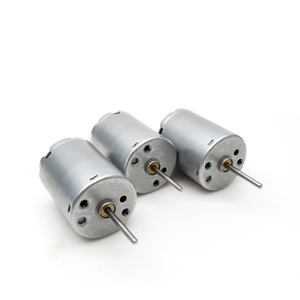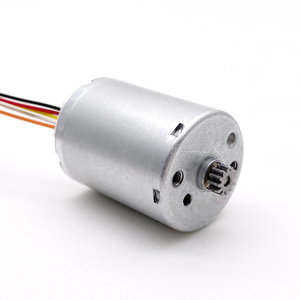
All categories
Featured selections
Trade Assurance
Buyer Central
Help Center
Get the app
Become a supplier

(7667 products available)













































24v pwm dc motor controller has various kinds. They include:
Basic PWM Controllers
These 24v controllers with variable speed for dc motors use simple circuitry to generate PWM signals. The signals control motor speed by adjusting voltage averages. These basic controllers provide simple speed adjustments for small to medium-sized motors in less demanding tasks. Often found in applications like small fans and electric toys, they offer affordable and efficient motor speed control solutions for simple applications.
Microcontroller-Based PWM Controllers
These controllers utilize microcontrollers or programmable chips to generate PWM signals. It allows for more complex and precise control over motor operations. These controllers enable speed control, direction changes, and even feedback mechanisms to adjust the motor based on load or speed requirements. They are prominent in robotics and automation, where programming flexibility and precision are vital. Therefore, users of microcontroller-based controllers can expect advanced control features for their dynamic and complex applications.
Analog-Controlled PWM Controllers
These controllers employ analog components to create PWM signals. They provide speed control via variable signals. Thus, it results in a smooth operation for tasks with consistent loads. While not as flexible as digital controllers, analog-controlled controllers are reliable in industrial machinery. In these machinery, users require straightforward speed regulation without additional programming complexity. In such scenarios, businesses prioritize dependability in their motor control systems to maintain continuous production. This allows for seamless integration into existing industrial setups.
Brushless DC (BLDC) PWM Controllers
Brushless 24v dc motor controllers are designed for brushless DC motors. They manage not just speed but also the direction of these motors. They do this by controlling how the power supplied to the motor phases is switched. Such controllers are vital in high-efficiency applications, including electric vehicles and computer cooling fans. This is due to their ability to maintain high-efficiency levels and low wear on the motor components. After all, unlike brushed motors, BLDC motors have fewer maintenance needs. Therefore, users should choose these controllers for their high-performance requirements and reliable long-term motor operation, with minimal downtime.
High-Power PWM Controllers
These 24v dc electric motor controllers handle large motor loads. They do so by managing power for industrial machines or heavy vehicles. The controllers utilize transistors or MOSFETs to handle bigger currents safely. These are vital in manufacturing tools, electric trucks, and other machinery that require solid motor control. Offer durability and stability. Users can rely on these controllers for managing larger-scale operations under demanding conditions. Once they do so, they will be assured that they will achieve efficient motor regulation.
The durability and materials of a 24v PWM DC motor controller impact its performance, dependability, and application suitability. These factors include:
Heat-Resistant Components
24v electric motors generate significant heat, especially in high-stress usages. Heat-resistant components such as thermoplastics or metal housings protect the controller. This helps maintain performance in areas subject to motor overheating. For industrial or automotive applications needing continuous operation, users must select controllers with solid heat tolerance to avoid performance drops from thermal stress.
Wear-Resistant Materials
Wear-resistant protective covers or housings for controllers are needed in areas exposed to dust, debris, or moisture. These materials help in preventing environmental damage. Manufacturers use materials such as sealed enclosures and corrosion-resistant coatings. These materials are vital in outdoor machinery and construction equipment. In such areas, dust and humidity can compromise electronic components. Controllers in these environments must offer additional protection against wear and tear.
Shock and Vibration Resistance
Vibration from frequent use, nearby machinery, or uneven terrains affects controller functionality. Therefore, manufacturers use shock-absorbing materials or housings. These include rubber mounts or reinforced casings to ensure continuity. Such designs provide controllers with durability in heavy-duty trucks, mining machinery, or construction equipment operating in extreme environments. Their durability in vibration-prone environments extends the life of the controller.
Durability in Humid/Corrosive Environments
Controllers operate in high-humidity or corrosive environments. Such environments can cause significant damage to electronic components. The most effective way to prevent this is to have corrosion-resistant materials. These materials include coated PCBs (printed circuit boards) and sealed enclosures to prevent moisture entry. Users in marine applications, wastewater treatment facilities, or chemical plants must choose controllers with solid corrosion resistance. After all, electronics failures caused by environmental damage are costly.
Quality Insulation Materials
Insulation protects the controller from voltage surges, electrical shorts, and excessive current. High-quality insulating materials protect the electrical components within the controller. Electric motors and controllers experience frequent power variations in applications like renewable energy systems. These can stress the components. Therefore, using durable insulating materials is integral to the controller's lifetime.
The controllers offer a large number of commercial benefits. These include:
Automatic Operation
These controllers automatically adjust motor speed, reducing the need for manual intervention. Therefore, they increase efficiency in applications like conveyor systems. They also enhance operational effectiveness across industries and reduce labor costs. Labor savings translate into lower operating costs for businesses, making the controllers commercially attractive.
Consistent Product Output
The controllers provide precise motor control, leading to more consistent product quality. This is vital for manufacturing where variable speeds cause product defects or inconsistencies. In such cases, the consistency of auto-carwash parts like sprayers, brushes, or dryers depends on the controllers. No wonder consistent quality reduces waste, saving money and enhancing commercial value. Users can offset the initial cost of the controller by reducing product rework and waste.
Decrease Energy Use
The controllers use energy-efficient PWM techniques to minimize power consumption. They lower the utility costs businesses incur daily and reduce their carbon footprint. Lower energy consumption directly benefits the environment and businesses' bottom line. With rising energy costs, any reduction in power usage has a significant commercial impact. The controllers must, therefore, have energy-efficient PWM techniques.
Product Longevity
These controllers enhance the operational life of associated equipment. They enable smooth motor operations, reducing wear and tear on mechanical components. Longer equipment life comes with lower maintenance and replacement costs. Over time, this savings pays for the controllers many times over. Long-lasting dc motors prevent vexing frequent replacements of expensive machinery components.
These controllers have wide applications. They are effective in a large number of situations. These situations include:
Electric Vehicles
The controllers regulate motor speeds for optimal efficiency and performance in electric cars and bikes. They provide smooth speed variations, enhancing the driving experience. No wonder they have become critical for managing battery consumption and extending the vehicle's range. This is why modern electric vehicles strive to achieve longer distances on a single battery.
Industrial Automation
In industrial settings, these controllers manage motors for conveyor belts, pumps, and fans. They provide precise speed control for maintaining production line efficiency. This precision ensures that materials move at the right speeds, decreasing bottlenecks and increasing productivity. Thus, increased productivity justifies the controller's cost by boosting output and efficiency in industrial applications.
Robotics
The controllers enable precise movement in robotic applications, such as automated arms and mobile robots. Their accuracy supports delicate tasks, including assembly or packaging. Accuracy is critical for operations that require intricate movements to prevent damage to components or products. That is why several industries prefer these controllers. After all, they offer commercial benefits because they have high needs but low incurs costs andರ್ಥ.
Cooling Systems
In HVAC systems, the controllers adjust motor speeds for fans and blowers. This maintains desired airflow levels for efficient heating and cooling. Proper speed modulation prevents energy wastage while ensuring that systems work at peak efficiency. As a result, businesses with large HVAC requirements prefer these controllers. They address their necessity for dependable temperature regulation and energy savings.
One must consider several factors to select the ideal 24v PWM DC motor controller. Here are those factors:
Load and Torque Requirements
The controller should match the motor's load and torque requirements in varying applications. High-torque motors need controllers with larger current ratings to manage the additional power demands. Conversely, small motors can function smoothly with basic controllers. Therefore, knowing the motor's load and torque needs aids in selecting a controller with adequate capacity for seamless operation. One will not experience inadequate performance or motor damage when using a properly matched controller.
Heat Dissipation Features
The heat produced by the controller influences its performance and durability. The more the 24v electric motor, the greater heat the controller will dissipate. A heat sink, fan, or good ventilation prevents overheating in high-power applications. Proper thermal management enhances efficiency and life of the controller. Pick out a model with excellent heat dissipation features if the application needs extended motor runs.
Speed and Precision
How fast and precisely the controller operates are vital in many applications. Areas with varying speed requirements need controllers with broad PWM ranges. These controllers enable fine speed adjustments for smooth operations. High precision is vital in robotics and CNC machines, where small speed variations cause significant effects. One should select a controller depending on their application precision and speed requirements.
Current Rating
The current rating of the motor and controller should match. A controller with a smaller current rating than the motor will fail to manage power demands, causing burnout and damage. Conversely, a controller with a higher rating will cause excessive energy wastage. In addition, the controller should have a good current rating.
User-Friendliness
Ease of installation and operation impacts controller selection. For example, in quick-application settings, plug-and-play designs decrease setup times. In addition, simple interfaces for adjustment make operational speed easy for non-technical staff. Many users prefer user-friendly controllers. This is because they do not need complicated installations or advancements in electrical knowledge for successful operations.
A1: Good heat dissipation prolongs the life of the motor controllers. After all, controllers exposed to excessive heat frequently suffer component damage over time. Good ventilation and heat sinks regulate controller temperatures during high-power operations. It ensures long life for the controller. In addition, THGs and cooling fans are standard fixes on these controllers to enhance their functioning.
A2: Regular cleanliness with gentle, dry, or slightly humid cloths is necessary, mainly if used in dusty outdoor conditions. One should check electrical connections regularly to ensure secure, corrosion-free contacts. In addition, ensure that the controller has reliable materials and good insulation to prevent electrical issues. A little effort goes a long way in ensuring the controller's optimal performance and a longer life.
A3: Voltage and current fluctuations affect dc motor controllers. However, proper external regulation with voltage stabilizers or surge protectors prevents such fluctuations. The stabilizers and surge protectors help maintain a constant voltage supply to the controller, preventing frequent electrical spikes or drops. With stable power, motor performance becomes reliable. It also protects the controller from potential damage caused by electrical irregularities.
A4: Yes, there are. However, it is vital to confirm compatibility with particular motor types. Universal controllers manage various brushed or brushless DC motors. However, non-bespoke brushless controllers have specific switching requirements. These requirements are such that only brushless 24V DC motor controllers can manage them. On the other hand, brushed DC motors function without special requirements and with ease from various PWM controllers. Universal controllers are ideal for practical applications where users must frequently switch motor types.
A5: Yes, they do. These motor controllers are well-loved since they service various applications. From automotive to HVAC and industrial machinery, electric bikes, and robotics, their application is endless. Because of their high efficiency and ability to control speed, these controllers go on to reduce energy consumption and operating costs. Thus, users can justify their costs while boosting application performance. With time, preference for these controllers increases due to their multipurpose use and efficient job performance.